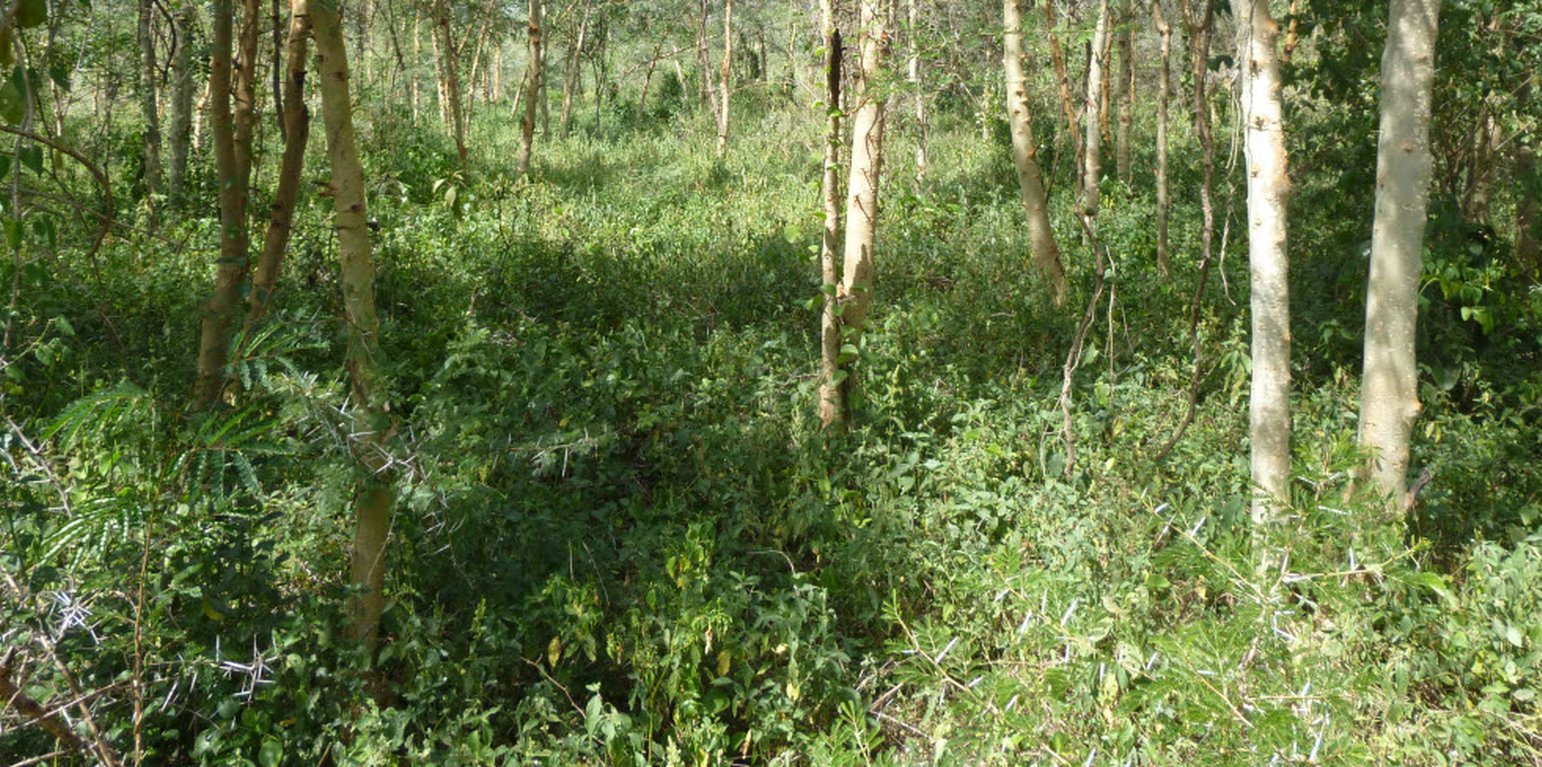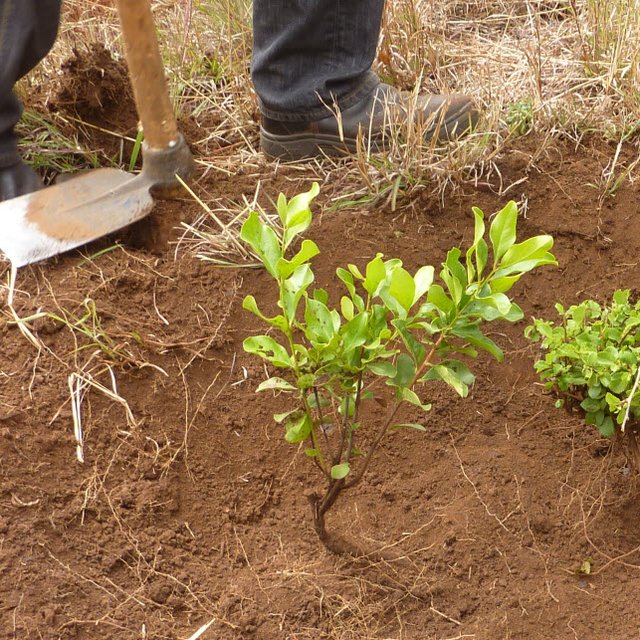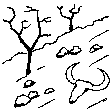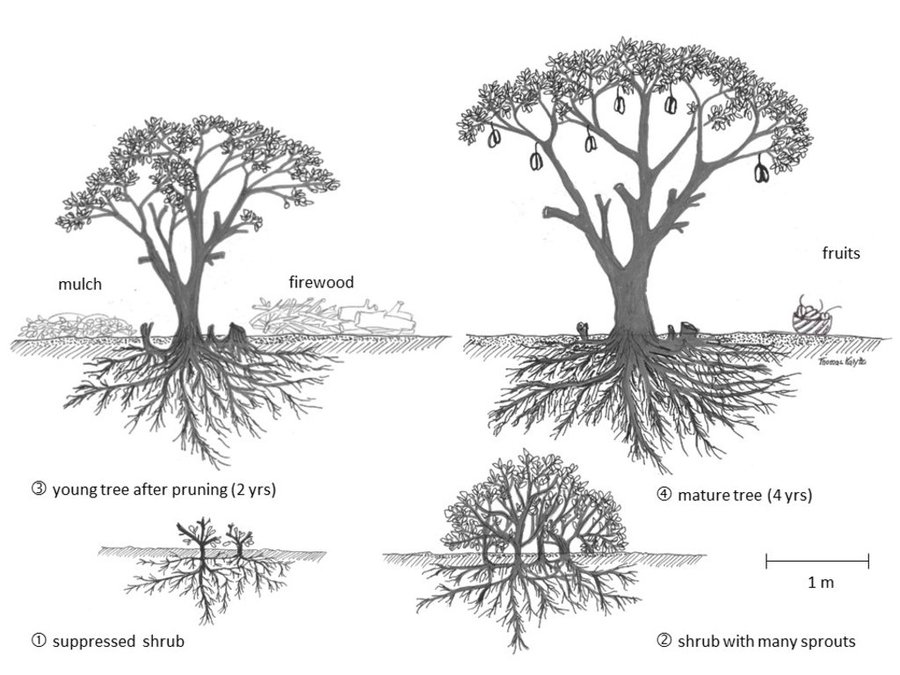



Conventional afforestation and tree planting requires considerable inputs, labour and care including suitable seedlings, transport of these, planting and regular watering - and the survival rate in arid and semi-arid climates is often very poor. On the other hand Farmer Managed Natural Regeneration (FMNR) is a cheap and effective way to restore and improve large areas of degraded and depleted soils. The technology relies on the fact that even in deforested areas, soils often still maintain some active roots systems and viable seeds of native woody plants. Selectively promoted, leaving only a few main shoots, they can grow into trees within a few years. This technology - based on indigen- ous practices - has been successfully promoted by World Vision in eight African countries including Kenya and Ethiopia, and is now also being applied in Indonesia, East Timor and Latin America. Apart from labour and a farmer’s knife, and skills, there are no major inputs required. The farmers like this agroforestry technology a it is cheap and can be easily combined with other SLM technolo- gies such as permaculture, inter-cropping, and mulching. At the same time it can be used at various scales: on small plots of less than one hectare or up to the landscape level where whole hills can be re-vegetated within a short period. And the impact can be very positive on the soil, ecology, cli- mate and health of crops, people and livestock. The farmer can use prunings as rewood, and grow fodder below the trees; tree branches and leaves can serve for mulching and the owers for bees, fruits for consumption and sale. The trees break the winds, protect the soil and (with some species) their shade protects sensitive crops (e.g. vegetables or even coffee) from the sun. The soil’s water retention capacity, structure, biology and fertility improve. All effects contribute to soil, water and climate stabilization. One limitation can be the use of tractors and other machines which, however, are hardly employed by smallholder farmers. Some practical steps for establishing an FNMR site; 1) jointly agree on a target area (be it a eld or communal wasteland) 2) check out the area carefully for existence of woody species (trees, bushes, rootstocks) 3) mark the bushes or trees that should be nurtured into bigger trees (it is recommended to consult local/scientific knowledge on the trees species and their positive benefits) 4) protect the whole area (fences, hedges) or only the chosen trees against grazing and human disturbance 5) when the plants reach a height of 1 m start with pruning, only keeping the 2-3 main shoots, using the prunings for rewood or mulching 6) watering is in most cases not required as the indigenous trees have well-enough developed roots for self- supply 7) the specific cultivation and management practice depends on the trees species selected and the desired results (intercropping with maize, shade trees for coffee, fodder trees for livestock, flower trees for bees etc.) 8) fire and livestock are the are the main threats for a new FMNR site.

ສະຖານທີ່: Suba and Mbita Sub-Counties, Homa Bay Country, ເຄັນຢາ
ຈໍານວນ ພື້ນທີ່ ທີ່ໃຊ້ ເຕັກໂນໂລຢີ ທີ່ໄດ້ວິເຄາະ: 10-100 ພຶ້ນທີ່
ການແຜ່ກະຈາຍຂອງເຕັກໂນໂລຢີ: ແຜ່ຂະຫຍາຍຢ່າງໄວວາໃນພື້ນທີ່ (approx. 1-10 ກມ 2)
ຢູ່ໃນເຂດປ່າສະຫງວນທີ່ບໍ?:
ວັນທີຂອງການປະຕິບັດ: 2014; ຕໍ່າກວ່າ 10 ປີ ຜ່ານມາ (ມາເຖິງປະຈຸບັນ)
ປະເພດຂອງການນໍາສະເໜີ









| ລະບຸ ປັດໃຈ ນໍາເຂົ້າ ໃນການຜະລີດ | ຫົວໜ່ວຍ | ປະລິມານ | ຕົ້ນທຶນ ຕໍ່ຫົວໜ່ວຍ (KES) | ຕົ້ນທຶນທັງໝົດ ຂອງປັດໃຈຂາເຂົ້າ ໃນການຜະລິດ (KES) | % ຂອງຕົ້ນທຶນທັງໝົດ ທີ່ຜູ້ນໍາໃຊ້ທີ່ດິນ ໃຊ້ຈ່າຍເອງ |
| ແຮງງານ | |||||
| plot protection - fencing/ ha | person-days | 30.0 | 400.0 | 12000.0 | 100.0 |
| tree protection - first pruning/ ha | person-days | 10.0 | 400.0 | 4000.0 | 100.0 |
| ອຸປະກອນ | |||||
| farmer's knife | piece | 2.0 | 150.0 | 300.0 | 100.0 |
| machete | piece | 2.0 | 500.0 | 1000.0 | 100.0 |
| rake | piece | 2.0 | 500.0 | 1000.0 | 100.0 |
| hand hoe | piece | 2.0 | 450.0 | 900.0 | 100.0 |
| leather gloves | pair | 2.0 | 1000.0 | 2000.0 | 100.0 |
| strong gumboots | pair | 2.0 | 2000.0 | 4000.0 | 100.0 |
| axe | piece | 2.0 | 700.0 | 1400.0 | 100.0 |
| ວັດສະດຸໃນການປູກ | |||||
| life fence seeds/ thorns of shrubs / ha | seedlings | 1200.0 | 5.0 | 6000.0 | 100.0 |
| ຝຸ່ນ ແລະ ຢາຊີວະພາບ | |||||
| n/a | |||||
| ວັດສະດຸກໍ່ສ້າງ | |||||
| n/a | |||||
| ອື່ນໆ | |||||
| n/a | |||||
| ຕົ້ນທຶນທັງໝົດ ໃນການຈັດຕັ້ງປະຕິບັດ ເຕັກໂນໂລຢີ | 32'600.0 | ||||
| ຄ່າໃຊ້ຈ່າຍທັງໝົດ ສຳລັບການສ້າງຕັ້ງເຕັກໂນໂລຢີ ເປັນສະກຸນເງີນໂດລາ | 326.0 | ||||
| ລະບຸ ປັດໃຈ ນໍາເຂົ້າ ໃນການຜະລີດ | ຫົວໜ່ວຍ | ປະລິມານ | ຕົ້ນທຶນ ຕໍ່ຫົວໜ່ວຍ (KES) | ຕົ້ນທຶນທັງໝົດ ຂອງປັດໃຈຂາເຂົ້າ ໃນການຜະລິດ (KES) | % ຂອງຕົ້ນທຶນທັງໝົດ ທີ່ຜູ້ນໍາໃຊ້ທີ່ດິນ ໃຊ້ຈ່າຍເອງ |
| ແຮງງານ | |||||
| Yearly Pruning of target bushes and trees /ha | person-days | 6.0 | 400.0 | 2400.0 | 100.0 |
| tree felling of selected trees/ ha | person-days | 4.0 | 400.0 | 1600.0 | 100.0 |
| ອຸປະກອນ | |||||
| farmer's knife | piece | 2.0 | 150.0 | 300.0 | 100.0 |
| machete | piece | 2.0 | 500.0 | 1000.0 | 100.0 |
| rake | piece | 2.0 | 500.0 | 1000.0 | 100.0 |
| hand hoe | piece | 2.0 | 450.0 | 900.0 | 100.0 |
| ຕົ້ນທຶນທັງໝົດ ທີ່ໃຊ້ໃນການບໍາລຸງຮັກສາ ເຕັກໂນໂລຢີ | 7'200.0 | ||||
| ຄ່າໃຊ້ຈ່າຍທັງໝົດ ສຳລັບການບົວລະບັດຮກສາເຕັກໂນໂລຢີ ເປັນສະກຸນເງີນໂດລາ | 72.0 | ||||
ປະລິມານ ກ່ອນການຈັດຕັ້ງປະຕິບັດ ການຄຸ້ມຄອງ ທີ່ດິນແບບຍືນຍົງ: 5 bags of maize / acre
ປະລີມານ ຫຼັງການຈັດຕັ້ງປະຕິບັດ ການຄຸ້ມຄອງ ທີ່ດິນແບບຍືນຍົງ: up to 8 bags of maize / acre
ປະລິມານ ກ່ອນການຈັດຕັ້ງປະຕິບັດ ການຄຸ້ມຄອງ ທີ່ດິນແບບຍືນຍົງ: Less than 10 bags (90kg) of harvested grass / acre
ປະລີມານ ຫຼັງການຈັດຕັ້ງປະຕິບັດ ການຄຸ້ມຄອງ ທີ່ດິນແບບຍືນຍົງ: More than 20 bags (90kg) harvested grass / acre
This applies to 1 acres piece of land that was not managed on FMNR compared to same size on good management FMNR and better quality fodder.
More wood is obtained from FMNR site because biomass increases faster and new ones regenerate faster. Before SLM, tree growth was suppressed.
ປະລິມານ ກ່ອນການຈັດຕັ້ງປະຕິບັດ ການຄຸ້ມຄອງ ທີ່ດິນແບບຍືນຍົງ: 0 beehive
ປະລີມານ ຫຼັງການຈັດຕັ້ງປະຕິບັດ ການຄຸ້ມຄອງ ທີ່ດິນແບບຍືນຍົງ: 10 Hives /acre
Beehive for honey production could be introduced as more vegetation and flowers are now available. Medicinal plants are also gaining in importance.
ປະລິມານ ກ່ອນການຈັດຕັ້ງປະຕິບັດ ການຄຸ້ມຄອງ ທີ່ດິນແບບຍືນຍົງ: Poor
ປະລີມານ ຫຼັງການຈັດຕັ້ງປະຕິບັດ ການຄຸ້ມຄອງ ທີ່ດິນແບບຍືນຍົງ: better
It was not easy to manage the land before FMNR application. After the SLM technology was adopted the farmers find it less hard to work their farms besides the land value also went up.
Since FMNR improves the soil cover, less erosion and siltation take place in the community dams; hence more water available. Equally, those who harness surface runoff are able to get water for micro irrigation within their homesteads.
ປະລິມານ ກ່ອນການຈັດຕັ້ງປະຕິບັດ ການຄຸ້ມຄອງ ທີ່ດິນແບບຍືນຍົງ: Low
ປະລີມານ ຫຼັງການຈັດຕັ້ງປະຕິບັດ ການຄຸ້ມຄອງ ທີ່ດິນແບບຍືນຍົງ: Medium
FMNR has provided additional/ alternative sources of income to the beneficiaries. Sale from wood, honey, medicinal components and non-wood products etc. This has led to a diversification of income sources.
The workload has increased slightly, depending on the density of FMNR trees on farm. The work is, however, more divers.
The more diversified livelihoods reduce the risk of food insecurity. The impact of disasters will reduced and the self-sufficiency has increased.
Some of the farmers established recreation sites as the microclimate improved and the beauty of the sites, more animals can be seen including birds and butterflies but at the same time also dangerous snakes appear. Some sacred sites have also been safeguarded.
Areas with deep gullies before FMNR application could be restored. Clear evidence that the technology has a high potential to rehabilitate degraded ecosystems.
Notable improvement. It has been proved that growing conditions and availability of water for crops under suitable trees can be much higher if the tree density is not too high.
The addtional vegetation provides protection of the soil against water and wind erosion.
Higher organic matter can be found on FMNR sites.
A biodiversity studies shows already after 3 sampling periods that more species are found on FMNR / restored sites.
Increase in population and density of indigenous tree species also as a starting point for management change towards agroforestry.
Many animal species find safe habitats in new FMNR sites.
Birds, butterflies, wild bees, spiders etc. - they control the pests and pollinate the crops.
Compared to degraded sites the FMNR sites provide more habitats e.g. in the trees or soil.
Still not yet proven but the expectation is that pests will be less harmful as the coping mechanism of the agro-ecological systems is better due to more predators (spiders, birds, frogs etc.)
FMNR serves also to mitigate the impact of annual floods to the crops and settlements.
FMNR improves the micro-climate and soil moisture. The technology therefore mitigates the impact of droughts.
Increase of tree cover through aforestation or FMNR as one of the ways to sequester carbon in biomass.
Tree cover can increase the risk of major wild fires. Fire breaks should be considered for larger FMNR sites.
The trees of FMNR serve as wind break and protect houses, greenhouses, and crop fields against heavy winds.
The micro-climate and humidity improves due to more vegatation and evaporation.
Increase in water retention which increases the ground water levels.
Due to less wind and water erosion the siltation of ponds and water pans is reduced.
Vegetation cover allows for good filtration and reduces the immediate surface water run off which can lead to flooding.
The additional tree cover acts as carbon sink and mitigation measure to global warming.